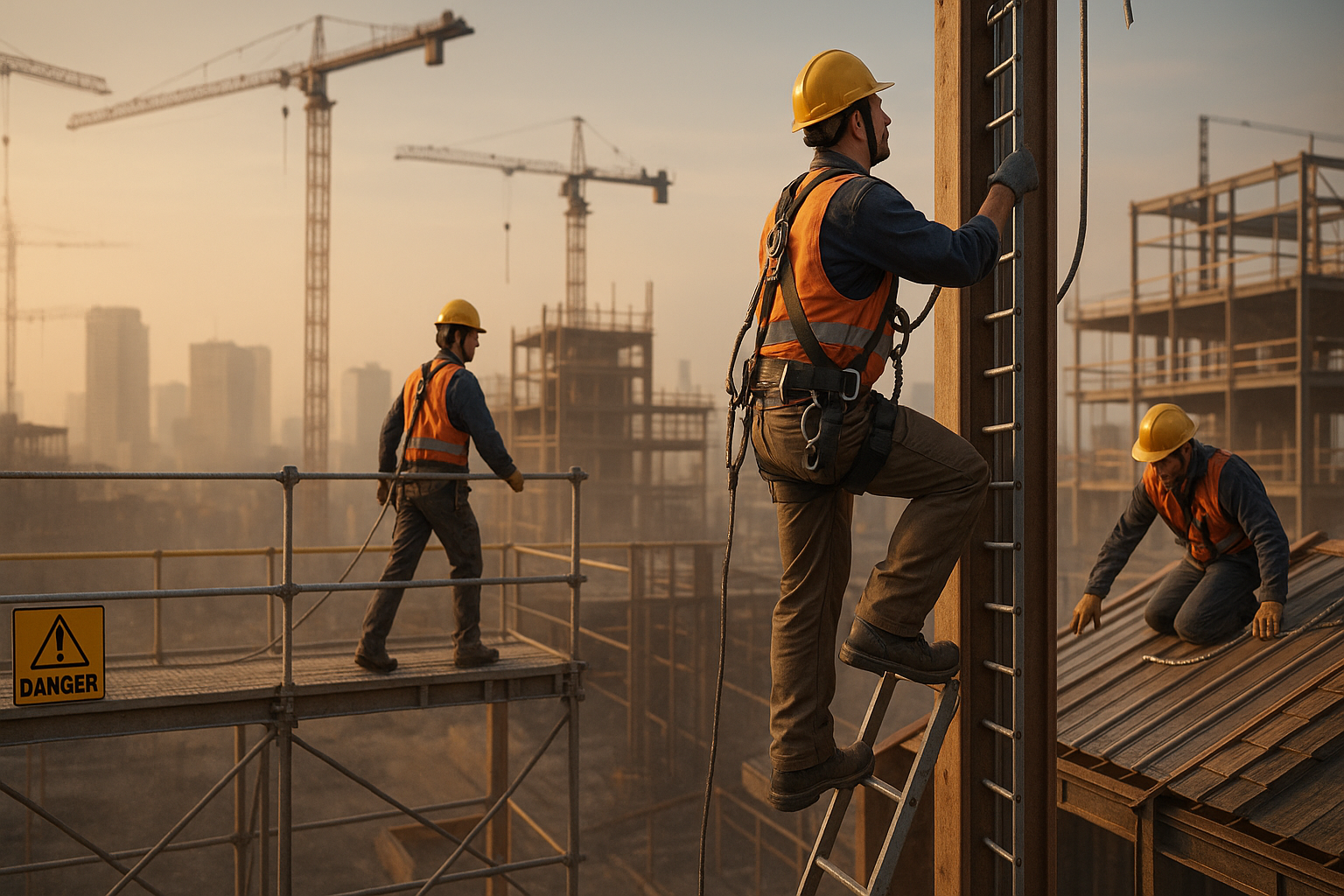Falling Hazards in Construction: A Complete Safety Guide
Learn how to prevent fall accidents on construction sites. Discover key safety systems, OSHA guidelines, and expert tips to reduce falling hazards in the workplace.

Preventing falling hazards in construction - essential safety systems and best practices
Falls are a leading cause of death in the construction industry. Every year, hundreds of workers suffer serious injuries or fatalities due to fall-related accidents. The good news? Nearly all of these incidents are preventable with proper planning, equipment, and training.
In this guide, you'll learn:
- What fall hazards are and where they occur
- The latest OSHA fall protection requirements
- The ABCs of fall protection systems
- How to safely use scaffolds, ladders, and powered platforms
- The importance of rescue planning and fall clearance
What Are Fall Hazards?
Fall hazards are situations where a person could unintentionally drop from one level to another. These often occur when working:
- Near unprotected roof edges
- On scaffolds or ladders
- Around floor holes or skylights
- In excavation zones
- On uneven platforms or incomplete structures
OSHA Fall Protection Requirements (2025 Update)
Under OSHA Standard 1926.501, fall protection is required whenever a worker is exposed to a vertical drop of 6 feet or more in construction environments.
Acceptable Fall Protection Methods
- Guardrails with toe boards
- Personal Fall Arrest Systems (PFAS)
- Safety net systems
- Covers for floor holes, pits, and skylights
- Warning lines and controlled access zones
Fall Prevention Systems: Know Your Options
1. Guardrail Systems
Guardrails are the first line of defense and must include:
- A top rail at 42 inches (±3 inches)
- A mid-rail halfway between the top rail and working surface
- Toe boards to prevent tools from falling
✅ Must withstand 200 lbs of force in any direction.
2. Warning Lines
Used to keep workers away from edges, warning lines must be:
- At least 6 feet from the edge
- Withstand 16 lbs of tipping force
- Minimum 34 inches high
3. Personal Fall Arrest Systems (PFAS)
The ABC Rule helps simplify PFAS:
- A – Anchor Point: Should support 5,000 lbs minimum.
- B – Body Harness: Must fit snugly and distribute forces safely.
- C – Connector: Includes lanyards, deceleration devices, or self-retracting lifelines (SRLs).
⚠️ Never tie off to pipes, rebar, or electrical fixtures.
4. Floor Covers & Skylight Protection
All floor holes or fragile surfaces (like skylights) must be:
- Clearly marked
- Covered with material that supports twice the weight of the worker and tools
- Secured to prevent displacement
Scaffold & Ladder Safety Best Practices
Scaffold Use
- Only work on properly constructed and supported scaffolds
- Base plates and mud sills are mandatory
- Install guardrails if working at 6 ft or higher
- Avoid stacking bricks or materials for extra height
Ladder Safety
- Inspect before every use
- Always maintain 3 points of contact
- Secure ladders to prevent slipping
- Extend ladders 3 feet above landing points
🚫 Never stand on the top rung.
Powered Access Platforms
Includes:
- Aerial lifts
- Scissor lifts
- Man baskets on forklifts
✅ Operators must be trained
✅ Workers must wear harnesses with lanyards
✅ Use only platforms designed for lifting personnel
Suspension Trauma & Rescue Readiness
Even after a fall is arrested, suspension trauma can occur in minutes if the worker is left hanging in the harness.
Emergency Planning Tips
- Use trauma-relief straps
- Plan a rescue procedure before starting the job
- Train personnel on emergency descent equipment
How to Calculate Fall Clearance Distance
You need adequate clearance below the anchor point. Here's a typical breakdown:
| Component | Distance |
|---|---|
| Lanyard length | 6 ft |
| Deceleration distance | 3.5 ft |
| Harness stretch | 1 ft |
| Worker height (D-ring to foot) | 5 ft |
| Safety margin | 3 ft |
| Total Required Clearance | 18.5 ft |
📐 Always calculate before you work.
How to Wear a Full-Body Harness (Step-by-Step)
- Grab the harness by the back D-ring
- Untangle and put on shoulder straps
- Connect and tighten leg straps
- Buckle the chest strap mid-chest
- Adjust all straps for a snug fit
- Secure loose ends using keepers
⚠️ A loose or misfitted harness can cause internal injuries during a fall.
Conclusion: Make Fall Safety a Priority
Whether you're a site supervisor, contractor, or safety officer, fall protection should never be an afterthought. A few seconds of preparation can mean the difference between life and death.
Quick Recap
- Identify fall hazards before work begins
- Use the right fall protection system for the job
- Train all workers on proper equipment use
- Always plan for rescue and suspension trauma
- Enforce safety rules—every shift, every worker
Remember: Safety isn't just compliance. It's commitment.
📎 Ready to Protect Your Team?
Looking for professional fall protection equipment and safety training? HSSPL offers comprehensive safety solutions for construction sites.
Related Safety Equipment
Fall Arrest Systems
Complete fall protection systems with harnesses, lanyards, and anchor points.
Horizontal Lifeline Systems
Engineered lifeline systems for continuous fall protection.
Roof Top Guardrails
Permanent and temporary guardrail solutions for rooftop work.
